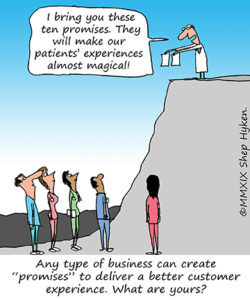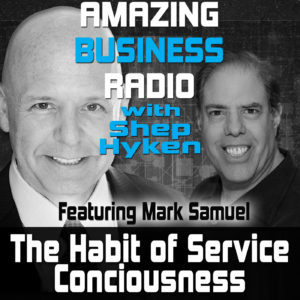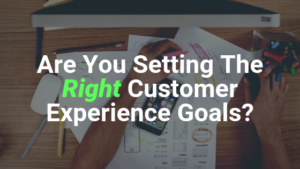Shep Hyken's Blog, page 133
January 23, 2019
Your Personal Promise to Your Customers
 Not long ago I wrote about Dr. Neil Baum’s Win-Wynn story. A few people went to his website and read his promise to his patients that he appropriately calls “My Personal Promise to You.” The feedback and comments about this promise were excellent, so I thought it was worth sharing with everyone. By the way, at the end of this article, I’ve shared a very important call-to-action for you. Be sure to read the entire article – or at least the last paragraph.
Not long ago I wrote about Dr. Neil Baum’s Win-Wynn story. A few people went to his website and read his promise to his patients that he appropriately calls “My Personal Promise to You.” The feedback and comments about this promise were excellent, so I thought it was worth sharing with everyone. By the way, at the end of this article, I’ve shared a very important call-to-action for you. Be sure to read the entire article – or at least the last paragraph.
For those that didn’t read the article or watch the video, Dr. Neil Baum is a world-renowned urologist. He not only prides himself on being an excellent doctor, but he also prides himself on delivering a great patient experience. I’m sharing his personal promise, and as you go through this list, keep in mind three things. First, this is a promise about the experience you’ll get when visiting his office, which is all about customer service. Second, notice how he’s working convenience into the promise, like how he arranges for prescriptions to be waiting for you when you arrive at the pharmacy. Third, he obviously cares. How many doctors give you an email address and promise to respond the same day?
Now, here is Neil Baum’s Personal Promise:
We will answer the phone in less than 3 rings … most of the time.
A human, not an answering machine, will speak with you and make your appointment or take your question.
We can usually make an appointment to see you on the same day that you call or the very next day.
If you call for the doctor or one of the patient assistants, we will call you back the same day and we tell you about what time that call will take place.
We use an electronic medical record and we will send your prescription to the pharmacy so that the medication will be ready when you arrive at the pharmacy. (This does not apply to the sleeping medication or pain pills, as the law does not permit electronic transfer of these prescriptions.)
We will send a letter to your primary care doctor or your referring physician while you are still in the exam room listing your diagnosis, the medications that I have prescribed, and the treatment plan that I have outlined for you. Now, if you need to contact your physician, they will be knowledgeable about what took place during your visit to my office.
We will provide you with educational material on your condition. Most of the articles that I will give you have been written by me and are also available on my website.
You can communicate with me or one of my staff via e-mail and I will answer you, usually within the same day. Please don’t use my email for emergencies or urgencies. For those situations, please call my office and I will call you immediately.
We have a very energetic, enthusiastic, and smiling staff who will help exceed your expectations regarding your visit to our office.
We will make your visit almost “magical.”
Here is your assignment. Look at this list and answer the question, “If I were his patient, what would I like about this?” The question becomes important when you ask the follow-up, “What can I take from this promise and apply to the way I treat my customers?” Maybe it’s time for you to write your company’s version of Dr. Neil Baum’s Personal Promise.
Shep Hyken is a customer service expert, keynote speaker, and New York Times bestselling business author. For information, contact 314-692-2200 or www.hyken.com. For information on The Customer Focus customer service training programs, go to www.thecustomerfocus.com. Follow on Twitter: @Hyken
customer service training programs, go to www.thecustomerfocus.com. Follow on Twitter: @Hyken

The post Your Personal Promise to Your Customers appeared first on Shep Hyken.
January 22, 2019
Amazing Business Radio: Mark Samuel

The Habit of Service Consciousness
Pulling Yourself and Your Company Toward Success
Shep Hyken interviews Mark Samuel. They discuss Mark’s new book, which outlines how to achieve success by breaking down silos, creating a vision of success, and emphasizing behaviors over outcomes.








In Shep’s Opening Monologue…
He addresses the age-old assertion that “the customer is always right” and argues that “the customer is NOT always right.
The Interview with Mark Samuel:
Mark’s book, B STATE: A New Roadmap for Bold Leadership, Brave Culture, and Breakthrough Results, details a paradigm shift that will lead individuals and companies to success. It’s about getting from point A to point B of success. To get to point B, you must first create a vision of what that B state is for you, then allow that to pull you along rather than trying to push yourself from the A state.
By focusing on middle management, cultural changes will trickle down to other areas of company, promoting growth and success.
There needs to be a level of human connection and concern in every interaction, and this begins internally in all organizations. More often than not, companies that are rated as good places to work will also be rated positively for their customer service.
The customer service industry is changing rapidly. To manage these changes, organizations need to not only handle problems in the present but forecast and strategize for future problems that may arise. The company needs to support the customer through these changes to ensure loyalty.
Maintain your own “service consciousness.” When you operate from a mindset of being in service to those around you, it will build positive service habits and ultimately help you deliver exceptional customer service. Find the joy in giving service and making genuine human connections.
Quotes:
“We have to help our customers adapt to what they need not only in the moment, but also in the future.” – Mark Samuel
“There’s so much joy in being of service, giving to and helping someone else, person to person.” – Mark Samuel
“Are you of service consciousness, or are you just doing a customer service job?” – Mark Samuel
About:
Mark Samuel is the founder and CEO of IMPAQ and has over 30 years of experience working with major companies around the world. His most recent book is B STATE: A New Roadmap for Bold Leadership, Brave Culture, and Breakthrough Results.
Shep Hyken is a customer service and experience expert, New York Times bestselling author, award-winning keynote speaker, and your host of Amazing Business Radio.
This episode of Amazing Business Radio with Shep Hyken answers the following questions … and more:
Is the customer always right?
What is the “B state” picture of success?
How can I break down business silos?
How can I turn customer service into a personal habit?
What is service consciousness?
The post Amazing Business Radio: Mark Samuel appeared first on Shep Hyken.
January 21, 2019
5 Top Customer Service Articles for the Week of January 21, 2019
Each week I read a number of customer service and customer experience articles from various resources. Here are my top five picks from last week. I have added my comment about each article and would like to hear what you think too.
Before you automate people’s jobs, here are some things to consider by Kindra Cooper
(LinkedIn) Industry wisdom holds that CX automation squares away the “boring” and “repetitive” parts of an agent’s job, thereby “freeing them to do more high-value work.”
My Comment: AI has been creating “quite a stir” in the customer service and support world. There has been talk about how AI and automation will take the jobs of the support team. We are a long way from that happening. While it can handle lower-level issues and repetitive tasks, there is (for the foreseeable future) the need for a balance between AI and people. This is an excellent article that lays out some of the facts, and as the title implies, some things to consider.
As Trust Among Consumers Wavers, Authenticity is Critical by Michael Fertik
(Forbes) Facebook might be under fire for questionable data management practices, but that doesn’t mean businesses should shy away from social media as a means of connecting with customers.
My Comment: Trust and confidence are part of the customer experience. The idea that a customer trusts you weighs into their decision to do business with you. Consider the facts from this article.”A high Reputation Score correlates with a 3.9% boost in sales.” And that 86% of people say authenticity matters when making a buying decision. This excellent article makes the case for the importance of including trust as part of your marketing and experience strategy.
It’s Never Too Late to Win with Customer Experience: The Comcast Turnaround by Adam Toporek
(Customers That Stick) Many organizations can survive, even thrive, without providing excellent customer experiences, without being customer-centric. Perhaps they have a dominant market position, perhaps they have little competition or none at all.
My Comment: Late last year a number of customer service and experience experts visited the Comcast headquarters. We were treated to a day of executive presentations that shared how they are turning around their customer service reputation. Several of us summarized that day. This is Adam Toporek’s view of the experience. Comcast is a great case study on how a big company goes about turning around its customer service reputation.
CX 101: What Is Customer Experience, AnyWay? by Erin Ollila
(SmarterCX) The SmarterCX team hit the streets to find out just how many people are or are not familiar with the term “CX” — so if you think you’re the only one who’s not 100% sure, this may put your mind at ease.
My Comment: I’m often asked what is the difference between customer service and customer experience. A number of years ago, those terms were interchangeable. While customer service is part of CX, but there is so much more to it. This short article has a great definition of CX and covers some of the basics.
Customer Experience by Tom Fishburne
(Marketoonist) Whenever I’m in the midst of a frustrating customer service exchange, I find myself reaching for a sketch pad.
My Comment: I’m a big fan of business cartoons that make a point, especially if the topic is around customer service and experience. This past week a post featuring some of Tom Fishburne’s cartoons popped up on my radar. As you read these, you’ll smile as you recognize the truth behind the humor.
Top Five Bonus
Excellence in Service by Copperberg
(Copperberg) We’ve put together a brand new eBook with Shep Hyken looking at Excellence in Service!
(My Comment) Last year I flew to Amsterdam to speak on customer service at an industry conference. Just a few days ago I received a short summary of the speech in the form of an ebook. You’ll have to give them your email address to get the ebook, but it’s worth it. They did an excellent job of sharing key takeaways from the presentation.
Shep Hyken is a customer service expert, professional speaker and New York Times bestselling business author. For information on The Customer Focus customer service training programs go to www.TheCustomerFocus.com. Follow on Twitter: @Hyken
customer service training programs go to www.TheCustomerFocus.com. Follow on Twitter: @Hyken

The post 5 Top Customer Service Articles for the Week of January 21, 2019 appeared first on Shep Hyken.
January 18, 2019
Guest Blog: Are You Setting the Right Customer Experience Goals?
This week we feature an article by Tim Houlne who writes about the importance of integrating technology into your business to provide the optimum customer experience. – Shep Hyken
This post is an excerpt from
Humach’s
latest eBook, The Guide to CX Success, which can
be
found here
.

It’s that time of year again. Time to start planning for your 2019 customer experience initiatives. Given the current state of technology, your strategic goals must now go beyond improving metrics. Customer Experience will be the primary focus for successful operations in 2019 but is that “unwavering commitment to better CX” controlled by smaller metrics that don’t have a big effect on the experience as a whole? How committed are you to creating a better experience for consumers if your strategic goals aren’t truly strategic?
The proliferation of AI and automation into our work and personal lives means that the nature of work is changing. This rings especially true in the contact center, where many of the simpler, repetitive tasks are still performed by humans. We see numerous instances of contact center operators focusing more on improving the tactical side of operations like reducing average handle time or getting more surveys filled out while ignoring the more strategic goal of improving efficiency and eliminating the redundant. It’d be like getting on an airline that’s committed to a great in-flight experience, but the pilot’s messages can only be 30 seconds in length, flight attendant interactions are limited, and you have a brief survey at the end asking how your peanuts were. Would you consider that a great customer experience? Would you believe they actually cared about how the experience was? Would you ever use that airline again?
Let’s say that you find that although each support interaction is handled by a human, the wait times for the customers are higher than they should be, which is negatively affecting your retention rates. You also find that a large percentage of interactions deal with simple copy and pastes from your knowledge base. The frustration of the delay outweighs the benefit of the human touch in this instance.
By deploying an intelligent virtual assistant in this scenario, these simple transactions can be automated by processing each inquiry and delivering the correct responses in the same time it would take an agent to search your knowledge base. This would eliminate the labor costs of Tier 1 agents while also improving the overall experience, as customers would now be receiving the attention they need in a timely manner. However, automation will not be able to handle every interaction, which is why human agents will still be needed for escalations. These agents will be more skilled and will function more as account managers than reps. The human component doesn’t disappear, but changes to accommodate the more complex interactions. Empathy will be crucial in these scenarios, and while this means that the agent handle times might go up since the interactions are more complex, the satisfaction, retention, and revenue metrics will increase dramatically as the higher touch service will happen when it’s needed most.
Technology is on your side. It’s a crucial part of the contact center and the longer you wait to deploy it the further behind your competition you fall. The old way of thinking about customer engagement is no longer satisfactory in a marketplace where customers demand instant gratification. The possibilities are limitless once you understand the best places in the customer lifecycle to deploy technology and change how you think about customer experience. By blending humans and machines, you can strive to reduce labor, increase revenue and overall customer experience, and control the market share in your industry.
To read the full Guide to CX Success, please
click here
.

Tim Houlne is the CEO of Humach, as well as a seasoned entrepreneur and former FORTUNE 500 leader. His vision at Humach is to help companies engage, acquire, and support customers by combining the creativity of humans with the computational power of machines. You can learn more about them here and you cant connect with Tim here.
For more articles from Shep Hyken and his guest contributors go to customerserviceblog.com.
Read Shep’s latest Forbes article: Representative … Representative … Representative!
The post Guest Blog: Are You Setting the Right Customer Experience Goals? appeared first on Shep Hyken.
January 16, 2019
Give Up Sex for Amazon?
 Customer Relationships
Customer RelationshipsHow much do you love the companies you do business with, the restaurants you frequent, or the stores you shop at? How upset would you be if they told you they were going out of business? What if you could save them by giving up something? So, the question becomes, “What would you be willing to give up to continue doing business with them?”
Before I go any further, I might be treading on dangerous ground with the word sex in the title of this article. I always keep my comments squeaky clean, and I hope that no one is offended by the word sex. We’ve become hyper-sensitive about words and I don’t want to upset anyone, especially our friends in HR, but we’re all adults and my reference to the word is, at most, PG-rated.
A recent article from Retail Customer Experience caught my attention – or, should I say, the title did: “Many Millennials Love Amazon More than Drinking, Sex.” Here’s the stat:
“A good majority of millennials, 77 percent, are willing to give up drinking and 44 percent are willing to give up sex before giving up access to Amazon.”
That stat comes to us courtesy of the Max Borges Agency survey about millennials and their commitment to doing business with Amazon. The survey polled 1,108 US consumers aged 18 to 34, who purchased tech products from Amazon in the past year.
This prompted me to do a little research. I Googled the question, “What would you give up sex for?” multiple ways. The typical responses were about health, sleep, happiness, and food. Apparently, this is a popular subject. There are plenty of answers and surveys to find. Yet none of the responses included the name of a retailer or any other business for that matter.
Well, I would say a new bar has been set by one of the world’s leading customer-focused companies. We may no longer be measuring how good a company is on a numeric scale, such as zero to ten, but instead on what a customer is willing to give up in exchange for the privilege of continuing to do business with that company.
So, how good are you? Would your customers be willing to give up drinking to continue to do business with you? How about sex? Here’s one… would your customers be willing to give up their mobile phones to do business with you? Now, that would be a great concession!
Shep Hyken is a customer service expert, keynote speaker, and New York Times bestselling business author. For information, contact 314-692-2200 or www.hyken.com. For information on The Customer Focus customer service training programs, go to www.thecustomerfocus.com. Follow on Twitter: @Hyken
customer service training programs, go to www.thecustomerfocus.com. Follow on Twitter: @Hyken

The post Give Up Sex for Amazon? appeared first on Shep Hyken.
January 15, 2019
Amazing Business Radio: Rebecca Martin

The Business of Emotion
Striking a Balance Between Technology and Human Connection
Shep Hyken interviews Rebecca Martin. They discuss the role of technology in customer service, how emotion can drive customer loyalty, and how marketers and contact center workers can help each other in building the ideal customer journey.








In Shep’s Opening Monologue…
He gives advice on how to create an amazing customer experience. His number one suggestion (right now) is to start with the culture of the company and the employee experience.
The Interview with Rebecca Martin:
Companies want to insert emotion into the customer experience. Emotion, or human connection, is what drives customer loyalty.
There needs to be a balance between technology and human connection. Too much reliance on technology can make customers feel displaced.
Chatbots and similar technologies are not replacing call center agents. By handling first-level calls, they are elevating the role of agents. This creates more of a career path within contact centers.
There is a higher call volume with more difficult problems reaching contact center agents. Companies need to reflect this change with improved training for their agents, so they can effectively and efficiently handle more difficult calls.
The phone is not dead in the support/contact center; it is simply used for different purposes.
The top three things that drive customer loyalty are quality products, action from the company in response to a complaint, and ease and efficiency of contacting the company. However, if the last two aren’t in place, customers will take their business elsewhere – even if the product is good.
Quotes:
“There’s a time and a place for digital interaction. There is always a place for human interaction.” – Rebecca Martin
“To stay ahead, companies need to figure out how to turn data into action.” – Rebecca Martin
“Be data-driven and action-oriented.” – Rebecca Martin
About:
Rebecca Martin is the Chief Marketing Officer at Calabrio, a customer engagement analytics software company. She has nearly 20 years of experience in the emerging technology industry.
Shep Hyken is a customer service and experience expert, New York Times bestselling author, award-winning keynote speaker, and your host of Amazing Business Radio.
This episode of Amazing Business Radio with Shep Hyken answers the following questions … and more:
What is the first step to delivering an amazing customer experience?
What are companies looking to change in how they do customer service?
What role does technology have in customer service?
How can marketers and contact centers work together?
What drives customer loyalty?
The post Amazing Business Radio: Rebecca Martin appeared first on Shep Hyken.
January 14, 2019
5 Top Customer Service Articles for the Week of January 14, 2019
Each week I read a number of customer service and customer experience articles from various resources. Here are my top five picks from last week. I have added my comment about each article and would like to hear what you think too.
Ten top tips for building a customer-driven company in 2019 by cp2experience
(cp2experience) I have framed all my top tips around the benefits to customers (and employees) and identified how technology can support the delivery of an enhanced, competitively distinct customer experience.
My Comment: Here’s a list of ten strong tips to help you and your organization become more customer focused. There’s something here for every company. One I’ve been talking about since the begging of my career in customer service and CX is number nine, which is speed and urgency. Today, more than ever, customers expect a fast response.
The True Cost of Losing a Customer by Susan Preiss
(Blue Ocean) One negative customer experience may seem like a drop in the ocean of all your customer interactions, but it’s never that simple.
My Comment: The cost of losing a customer is more than losing just one sale. Assuming your customer would have had a positive experience, he/she would likely come back and spend more. Not to mention the loss in word-of-mouth referrals. According to this article, only 42% of companies can accurately measure the lifetime value of a customer. But, once you do, you’ll have a better understanding of the impact of bad service and the cost of losing a customer.
Panviva Publishes E-Book: Building a Better Customer Experience—Tips from 10 CX Industry Experts by Dawn Corrente
(Panviva) Get a jumpstart on your 2019 planning with this collection of CX insights from our top 10 industry experts
My Comment: Are you ready to deliver a better customer experience? Of course you are. This is an ebook that features ten CX experts’ thoughts and strategies on how to go about it. I’m honored to be one of the ten. You’ll have to share your email address to get the download of the ebook, but it’s well worth it.
4 Ways Customer Journey Maps can Improve Customer Experience by Michael
(Freshdesk) Growing a successful business requires a strong understanding of your target audience. Beyond knowing the basic demographic information of the ideal customer, marketers also need to be familiar with their needs, interests, and decision-making process.
My Comment: I’m a fan of the customer journey map. It helps you identify important touch points that contribute (or detract) from the customer experience. Here’s a nice article that has several good ideas to help you take advantage of the work you put into the journey map exercise.
Great CX Requires a Cross-Team Commitment to Customer Centricity by Josh Brown
(Appcues) Great CX is not just a team sport—it’s a cross-team sport that requires a company-wide commitment to customer centricity in order to get right.
My Comment: Customer experience is everyone’s job. Consider this quote: “… the goal should be for all members of your organization to consider themselves ‘guardians of customer centricity’ in one way or another.” It’s not just for the front line. That’s the premise for this article that is filled with stats, facts and several excellent ideas to help your entire organization deliver a better CX.
Shep Hyken is a customer service expert, professional speaker and New York Times bestselling business author. For information on The Customer Focus customer service training programs go to www.TheCustomerFocus.com. Follow on Twitter: @Hyken
customer service training programs go to www.TheCustomerFocus.com. Follow on Twitter: @Hyken

The post 5 Top Customer Service Articles for the Week of January 14, 2019 appeared first on Shep Hyken.
January 11, 2019
Guest Blog: Customer Feedback Loops – 3 Examples & Strategies
This week we feature an article by Agi Marx who shares 3 ways to close the customer feedback loop to prevent churn and increase revenue. – Shep Hyken
What is the customer feedback loop?
Customer feedback loop is the practice of responding to customers meaningfully when they leave feedback. For example, if a customer complains about being overcharged, the company may respond with an apology and issue a refund.
But not all feedback is customer complaints. Customers also leave feedback when they have a particularly memorable experience. Or they may have suggestions for improvements or feature requests.
What many companies don’t realize is that they can turn this feedback into revenue. Here, we will first discuss why closing the loop is important, then provide three examples of how to grow your business thanks to customer feedback, and finally explain how to implement something like this in real life, using technology!
Why the customer feedback loop is important?
Did you know that it can be anywhere from five to 25 times more expensive to acquire new customers than to retain existing ones? Companies around the world have recognized this. Most successful companies invest heavily in designing special customer experiences and implementing structured customer success programmes. For example, Apple hhascarefully designed even something as rare as the process of unboxing a new Mac computer. Their Genius bars for technical support are also an innovation.
But there is one area of customer experience which is often overlooked, even by the most successful companies. Most companies ask customers for feedback, but when it comes to closing the loop on that feedback, most still use these two rudimentary strategies, if at all:
After a customer responds, they send “Thank you, we received your feedback”.
They only reach out to the most extremely negative responses as defined by the scores left alongside the comment. In the case of Net Promoter Score (NPS) surveys, this may mean they only get back to “Super Detractors”, i.e. those who leave a score of 0, 1 or 2 on a 11-point scale. They are the most at-risk customers, who are likely to churn and give a bad review.
At Thematic, we’ve looked at churn data across all NPS scores and found that churn is present across all responses. The below graphs outline real churn numbers from an existing company.
The graph on the left, shows that among customers who gave a “likelihood to recommend” score of 0 in the NPS survey, they have almost 7% churn rate, but among those who gave a score of 10, only 3.5% churn.
However, in this company’s case, there are significantly more Promoters than Passives and Detractors. So when we look at the actual number of people who churn, there are more of them among higher scores.

In summary, while the “Super Detractors” do tend to churn more, up to 75% of all churn happens across just any score that a customer might give, so we can see that most churn occurs outside of the Super Detractors , so by focusing on low scores only, companies will ignore the bulk of customers who will churn.
Closing the loop meaningfully is important. Without it, companies are missing out on retaining key customers, and even on additional revenue, as we can see in the following examples. And don’t worry, we understand that time to respond is limited and have come up with an automated way of closing the loop.
3 Amazing Examples of Closing the Customer Feedback Loop
1. Make it easy for people who love you to spend more money with you

My friend Ann-Margaret used to be an accountant. She now owns a cupcake shop which is incredibly successful. There are customers who visit her each week. I was one of them, when my daughter Maya went to a Saturday school next door. We told Ann-Margret how much we love her cupcakes and she shared that she also bakes for birthdays and functions. Next time I ran an event, I ordered 250 cupcakes from her store.
This process shouldn’t be different for a large company that receives thousands or hundreds of thousands of positive feedback pieces each year. Instead of “Thank you for your feedback”, the company should make it easy for a happy customer to buy more. Why not send a personalized offer, mentioning specifically what the customer said?
For example, if someone leaves a comment saying, “Your new website is much better than your old one”, the company could respond “We are so happy that you liked our website! Did you know that we also have an app, which you can use on the go? Download our app to get 10% on your next purchase.”
In fact, any personalized message that features specific things that a customer loved about your services makes it clear that you have listened and creates a mini-dialogue which ultimately builds a long-term bond with your customers.
2. Stop customers from leaving by closing the loop meaningfully
At Thematic, we have analyzed millions of feedback pieces and have found that there is a clear link between what people say and what they do in the following months. We see a lot of feedback from customers with the following sentiment: “I’ve been a customer for twenty years, but you only give great deals to new customers”. Customers want to feel valued. If they don’t, they are likely to switch to a competitor offering them a better deal.
Let’s go back to that churn example and show how looking at specific things people are talking about can help us pinpoint the things that will most prevent churn. We found that each company has certain recurrent themes in their feedback that have a significant indication of churn. Here is a slightly redacted example from the same dataset we used above. It’s showing that when people talk about improvements in delivery, they are less likely to churn, whereas when they mention loyalty (e.g. not being valued), the fact that they are thinking of canceling or have issues with payment, they are more likely to churn.

By analyzing past data and knowing which themes are highly linked to churn, companies can:
a) act on those issues to minimize their effect in the future, and
b) immediately close the loop with such customers preventing them from leaving.
If a customer mentions themes that indicate that they aren’t valued as a customer, it’s the perfect opportunity to show to a customer that you appreciate their loyalty and offer some sort of loyalty reward. After all, it’s only fair.
Or, to give another example, if someone comments on how the website is very difficult to use, you could respond with an email describing new upcoming features that will address these issues. Don’t just show that you are listening and this feedback is valuable, but also get the customer excited about what’s next in store!
3. Acquire new customers through advocacy
Positive feedback can also be used in a meaningful way. Imagine a customer, let’s call him Adam, has said: “I love your weekly deals section”. A powerful way of closing the loop would be to acknowledge this by saying:

A message like this one increases the likelihood of Adam making another purchase, leaving feedback next time the company sends him a survey and creates an easy way of sharing his positive experience with others in a win-win situation.
How to create a personalized closing the loop strategy?
So, you have hundreds, or thousands, of people leaving feedback each month. What are the right steps for closing the loop? How do you actually implement this? Here are some steps to consider.
1. Coming up with a closing the loop strategy
First of all, decide what will create the greatest impact on revenue?
If you have a high NPS or satisfaction score, you might not have that many Detractors. People are already saying that they are advocates of your brand. What’s the best way of activating them? Identify some of the key themes in feedback and for each theme, the most suitable response and possibly an offer.
If you have a low NPS and/or high churn, you need to address that first. Why are people churning? What would have kept them going?
If you analyze your customer feedback during different periods of time, say 12 and 3 months ago and link it to churn behavior, you’ll get an insight into any possible causes, as well as themes in their feedback indicative of churn.
Have at least ten conversations with customers who have churned, to get a deeper understanding of why and if there would have been anything to make them stay.
Put some dollar values against what those customers are spending to get an understanding of revenue at risk, and the value of investing into closing the loop and actions to retain future customers. Create and launch personalized responses based on themes and actions/offers tailored to retaining those customers.
2. Implementing closing the loop workflows
Believe it or not, but we have worked with one software company, who had a working system for closing the loop built on Google Apps and Zapier, an integration system. Once the feedback is collected, it’s funneled into a Google Spreadsheet.

A reviewer annotates each comment with a theme (what it’s about, such as a new feature request). Once the comment is ready for responding, for example, when the requested feature is shipped, a reviewer marks this comment as ready for a response. Zappier monitors that action and creates an email in Gmail sending it to the user.
This is one possible flow that does not need a software developer, but it does take a bit to set up and to monitor. At Thematic, we can help customers automate aggregating feedback in one place, annotating of the comments with relevant themes, and setting up the closing the loop workflows.
3. Including customers who haven’t left any feedback
Finally, not everyone leaves a comment, but with the right tools, you can close the loop automatically for a good proportion of your customers without the noise and bias.
In addition, you could find customers similar to those who did leave feedback by identifying key attributes that churned vs. happy customers share. The more you automate, for example, theme extraction and workflows that trigger responses, the more you can test whether your strategy is working and actually making a difference.
In summary, closing the loop is a critical step in monetizing your customer feedback strategy. It can help you not only retain customers who make it very clear that they are at danger of leaving, but also bring in new revenue by making it easy for happy customers to spend more and spread the word among their friends. Whether you are a small cupcake shop or a multi-billion dollar business, thinking about the specific touchpoint of receiving feedback and making the most of it should be on your agenda.
Agi Marx is the Director of Digital Marketing at Thematic, a platform to find insights in all your customer feedback.
For more articles from Shep Hyken and his guest contributors go to customerserviceblog.com.
Read Shep’s latest Forbes article: How To Raise Prices And Keep Customers
The post Guest Blog: Customer Feedback Loops – 3 Examples & Strategies appeared first on Shep Hyken.
January 9, 2019
No Toilet Paper – Is Customer Service Getting Worse?
 Some people claim that customer service is getting worse. I disagree. Customers are getting smarter and expecting more. The customer service “bar” is raised by great companies who teach us what good customer service should be. And, when there is a customer service “horror story,” it seems to stand out much more than when everything is right and works the way it’s supposed to.
Some people claim that customer service is getting worse. I disagree. Customers are getting smarter and expecting more. The customer service “bar” is raised by great companies who teach us what good customer service should be. And, when there is a customer service “horror story,” it seems to stand out much more than when everything is right and works the way it’s supposed to.
My friend, Shary Raske, a motivational speaker and coach, sent in a story that reminds me that sometimes common sense isn’t so common. This is the perfect example that might cause someone to think, “Customer service is getting worse!”
Shary was on a road trip and needed to stop for gasoline. Before filling up the car with gas, she decided to go to the bathroom. She noticed there wasn’t any toilet paper in the woman’s restroom. After making sure the men’s room wasn’t being used, she checked there. No toilet paper there, either
So, Shary went asked the attendant working behind the counter and asked for toilet paper. His response was, “We don’t have any.”
Now, this was a convenience store, and guess what? There was plenty of toilet paper for sale. All the attendant had to do was give Shary a roll of toilet paper. Now, some of you may point out, that the toilet paper on the floor is for sale, not for use. So, what! This isn’t like the attendant had to work hard to come up with a creative solution. The toilet paper was staring him in the face. Was he worried his manager might be upset? If so, shame on that manager!
Well, the attendant did come up with a solution. He told Shary, “You could use the toilet at the gas station across the street.”
She did. She also bought $26.67 worth of gas across the street.
Here are just three thoughts on this rather unfortunate situation:
It’s obvious the employee was not empowered. That could be a sign of bad training.
Maybe this was a just a “bad hire.” Had Shary come at another time, a different employee might have recognized how simple the solution was and fixed the situation. Yet this employee was all Shary will remember about this store. One employee can create a perception for all employees.
Why weren’t the bathrooms checked on a regular basis for cleanliness and toilet paper? This is standard operating procedures for many public restrooms in restaurants, gas stations – really almost anywhere.
There are more lessons and ideas to be discussed, but you get the idea. Sometimes the solution is so simple, it’s almost ridiculous that someone can’t come up with it. Share this story with your team. Ask them what their thoughts are about what happened. Sometimes a bad customer service example is a great learning opportunity.
Shep Hyken is a customer service expert, keynote speaker, and New York Times bestselling business author. For information, contact 314-692-2200 or www.hyken.com. For information on The Customer Focus customer service training programs, go to www.thecustomerfocus.com. Follow on Twitter: @Hyken
customer service training programs, go to www.thecustomerfocus.com. Follow on Twitter: @Hyken

(Copyright © MMXIX, Shep Hyken)
The post No Toilet Paper – Is Customer Service Getting Worse? appeared first on Shep Hyken.
January 8, 2019
Amazing Business Radio: Claire Boscq-Scott

The Culture of Caring
Creating an Unforgettable Customer Experience Every Time
Shep Hyken interviews Claire Boscq-Scott. They discuss the importance of a workplace culture of caring and how it can positively impact the customer experience.








Shep’s Opening Monologue
In Shep’s opening monologue, he elaborates upon the idea of amazing your employees so that they, in turn, can amaze your customers.
The Interview with Claire Boscq-Scott:
Every employee needs to understand their role as it applies to the customer experience, even if they have no direct contact with the customer.
What is felt on the inside of a company by its employees will be felt on the outside by its customers–that’s why it is crucial to create and foster a culture of caring.
Claire starts the relationship with her clients with a company audit that addresses three important issues:
1. The first thing to examine is the work environment. Claire audits the environment and implements changes to make it more pleasant to both workers and customers. If the environment is pleasing and inviting, then employees will want to come to work and customers will want to spend money.
2. The second area of focus is your employees. They need to understand the entire map of the customer journey and how they fit into the bigger picture of the customer experience. If they feel that their company cares about them, they will be more loyal and their performance will be better.
3. The third thing is, of course, the customers themselves. The goal is to create a positive, unforgettable customer experience every single time.
Being too focused on results can sacrifice the caring aspect of your business. This will ultimately prove detrimental to the customer experience and to your business.
Quotes:
“If we look after the employees’ journey, then we can look after the customers’ journey.” – Claire Boscq-Scott
“If you care about how people, both employees and customers, are feeling, they’re going to care about you and your business.” – Claire Boscq-Scott
“If there are no customers, there’s no business!” – Claire Boscq-Scott
“Everything we do in life is about relationships.” – Claire Boscq-Scott
About:
Claire Boscq Scott is a speaker, trainer, “coachsultant,” self-described “busy queen bee,” and author of the recent book Thriving by Caring.
Shep Hyken is a customer service and experience expert, New York Times bestselling author, award-winning keynote speaker, and your host of Amazing Business Radio.
This episode of Amazing Business Radio with Shep Hyken answers the following questions … and more:
How do you create an unforgettable customer experience every time?
What is the culture of caring?
How can a business amaze its employees?
How does the work environment affect the customer experience?
How do employees who never interact with the customer still affect the customer experience?
The post Amazing Business Radio: Claire Boscq-Scott appeared first on Shep Hyken.



